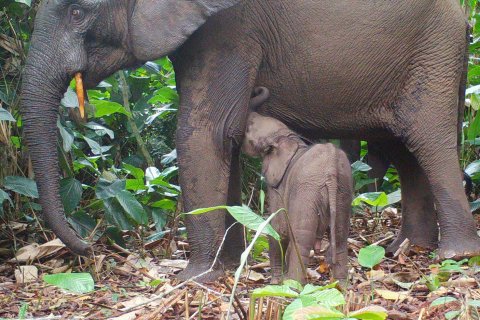FSC-certification of tropical forests proves beneficial for gorillas and elephants
Measures against illegal hunting turn out to be effective
Forest Stewardship Council (FSC)-certified timber harvesting areas in Gabon and Congo boast a greater abundance of larger mammals, such as leopards, gorillas, and elephants, than non-FSC forests. Utrecht University researcher Joeri Zwerts and colleagues conclude this based on 1.3 million camera trap images gathered in fourteen commercially exploited forests. The researchers' analysis reveals the effectiveness of wildlife conservation measures in FSC-certified forests. Today, the results of the study are published in the scientific journal Nature.

FSC, a non-profit organization, is dedicated to advocating responsible forestry practices to foster a healthy, resilient natural environment and to enhance the social and economic well-being of communities. In pursuit of these goals, the FSC issues certificates to timber harvesting companies that meet a set of conditions.
According to biologist Joeri Zwerts, up to now no independent research has provided conclusive evidence that FSC certification leads to strong benefits for forest biodiversity. Yet in making informed decisions about endorsing a label, consumers, policymakers, and NGOs require clear identification of the label's actual impact. This means it was high time for a comprehensive study, which was initiated by Utrecht University researcher Marijke van Kuijk and carried out with the backing of the World Wide Fund for Nature and the Wildlife Conservation Society.
More large mammals
Zwerts and his colleagues now provide compelling evidence for the positive impact of FSC measures on animal biodiversity in tropical forests. The researchers placed camera traps with motion sensors in fourteen timber harvesting areas in Congo and Gabon: seven managed by FSC-certified companies and seven comparable areas managed by non-FSC companies. Over a span of two to three months per field site, the approximately thirty camera traps per area together captured 1.3 million photographs.
While the photographs revealed comparable populations of small mammals, like mice and squirrels, in both FSC-certified and non-FSC areas, a different picture emerged when the researchers focused on mammals weighing over ten kilograms: higher numbers of these animals were observed in FSC areas compared to non-FSC areas. In FSC-forests, 3.5 times more animals weighing between ten and thirty kilograms were observed, such as antelopes and African golden cats. Animals weighing between thirty and one hundred kilograms, such as leopards and chimpanzees, were seen 2.5 times as often. Moreover, animals exceeding one hundred kilograms in weight, such as elephants, were photographed 2.7 times more often. Across FSC-certified areas, there was an overall 2.7-fold increase in the observations of animals classified as critically endangered species.
The study's findings underscore the significant role certification can play in conserving biodiversity in tropical regions.
Hunting
Zwerts explains that illegal hunting is a significant contributor to the loss of biodiversity in timber harvesting areas. Typically, tropical forests are poorly accessible. For the purpose of forestry, however, roads are constructed as the forests contain many tree species of which only a few are commercially viable for harvesting. These roads open up larger portions of the forests to poachers. Zwerts: "In hunting, the larger mammals are predominantly targeted. Moreover, the populations of these larger animals recover more slowly from hunting than populations of smaller species. This, in turn, has cascading effects, as large animals play vital roles in the forest ecosystem. They contribute to seed dispersal, facilitate nutrient recycling through their droppings, and indirectly influence the carbon storage capacity of the forest."

Various measures are implemented to counter illegal hunting in FSC-certified areas. These include the closure of old roads, the establishment of checkpoints along main routes, and regular patrols by anti-poaching units. Additionally, protein sources such as meat and fish are introduced to local communities, reducing the necessity for hunting to meet their protein requirements. Zwerts: "These measures lead to a higher abundance of large wild animals in FSC-certified areas, resulting in a significant contribution to animal biomass. This, in turn, has a profound impact on the ecosystem."
By opting for FSC-certified wood at the hardware store, you actively contribute to the conservation of beautiful and endangered species like forest elephants.
Adding value
“The study's findings underscore the significant role certification can play in conserving biodiversity in tropical regions,” says Van Kuijk. After all, a substantial portion of the tropical forests that still exist today is used for harvesting timber; in total, there are 400 million hectares of timber harvesting area in the world, more than ten times the size of Germany.

While it may appear contradictory, timber harvesting can in fact serve as a means to ensure the continued existence of tropical forests. Zwerts clarifies: "Local communities require income. Extracting hardwood adds value to the forest. Alternatively, if, for instance, soy or oil palms were cultivated in the same area, the forest would be lost, leading to significant consequences for biodiversity."
According to Zwerts, the results highlight the impact consumers can have. "By opting for FSC-certified wood at the hardware store, you actively contribute to the conservation of beautiful and endangered species like forest elephants." Jaap van der Waarde, who works with WWF Cameroon and is a co-author of the article, adds: "These findings bring encouraging news for FSC-certified companies, indicating that they are heading in the right direction."
Publication
FSC-certified forest management benefits large mammals compared to non-FSC
Joeri Zwerts, Elisabeth Sterck, Pita Verweij, Fiona Maisels, Jaap van der Waarde, Emma Geelen, George Tchoumba, Hermann Zebaze, Marijke van Kuijk
Nature, 10 April 2024. DOI: 10.1038/s41586-024-07257-8

